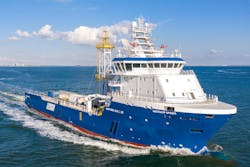Three Geoquip to support CVOW project offshore Virginia
Offshore staff
SAINT GALLEN, Switzerland – Geoquip Marine has secured a contract to work on Dominion Energy’s Coastal Virginia Offshore Wind (CVOW) commercial project off the coast of Virginia Beach, Virginia.
This is the first time the company will simultaneously deploy three of its DP-2 vessels: the Geoquip Saentis, Geoquip Speer, and Dina Polaris. It is also the first deployment of the Geoquip Speer since it was acquired and refitted.
The contract stipulates the drilling of deep boreholes and deep push seabed cone penetration tests (CPTs) at multiple locations in the main lease area plus shallow push seabed CPTs and shallow boreholes at multiple locations along the export cable route.
The company is responsible for all laboratory testing and final geotechnical reporting for the main lease area and along the export cable route.
The geotechnical vessel Geoquip Saentis is currently configured to perform deep push seabed CPTs and has the dual capability to switch modes to perform deep boreholes with the heave compensated GMR600 drill rig, which is located over a 4 m x 4 m (13 ft x 13 ft) midship moonpool.
The Geoquip Speer is currently configured in drilling mode with the heave compensated GMR302 drill rig, which is suitable for drilling, coring, sampling, and in situ testing in all soil conditions.
The Dina Polaris is mobilized with the company’s designed and built GMTR120, which is suitable for drilling, coring, sampling and in situ testing at depths down to 2,500 m (8,202 ft). The vessel is certified ‘Clean Design’.
All three vessels are fitted with an offshore soil laboratory, enabling Geoquip geotechnical engineers to conduct offshore soil classification and determine strength parameters for design, analysis, and assessments in real time. The data allows engineers to prepare borehole logs onboard as the borehole progresses, allowing an optimization of the actual borehole depth.
07/27/2020
